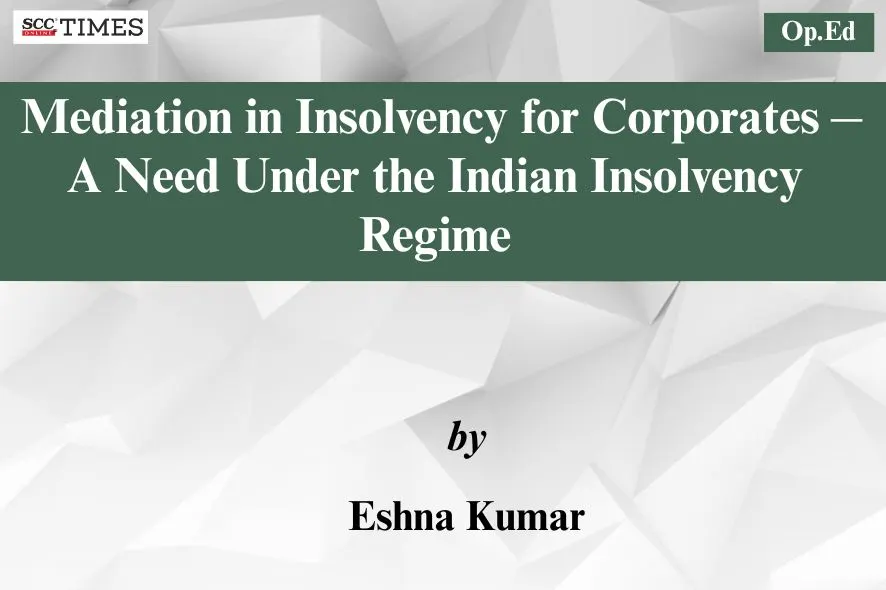Mediation in India is an accepted non-adversarial alternative dispute resolution to settle disputes between parties. The introduction of it in the Indian insolvency regime for corporate insolvency or liquidation wherein complex commercial issues arise is the need of the hour in order to curtail litigation, promote entrepreneurship, enforce business relationship and ensure that there is least deterioration of assets. This essay attempts to explain how this could be achieved.
The law of mediation in India
Mediation under the Indian law was statutorily recognised by the Industrial Disputes Act, 19471. The Legal Services Authorities Act, 1987 provided for establishment of statutory bodies at the National, State and sub-district (taluka) level to ensure access to justice for all and to promote pre-litigation conciliation and settlement through People’s Court (Lok Adalats).2 Thereafter, the Arbitration and Conciliation Act, 1996 was enacted with the introduction of conciliation.3 Inspired by the formulations of Lord Woolf incorporated in his classical work Access to Justice, the Civil Procedure Code, 1908 was amended in 1999 to include mediation as a form of alternative dispute resolution under Section 89, Insolvency and Bankruptcy Code, 2016 (the Code). This was for the first step under the Indian regime. This was further strengthened on 5-3-2018 for commercial disputes by the introduction of Section 12-A, Commercial Courts Act, 2015 which mandates a pre-litigation mediation for a civil suit relating to a commercial dispute.
India now has a dedicated legislature — the Mediation Act, 2023 (the Act). The highlight of the Act is the mediation settlement agreement, which records the terms of the agreement, authenticated by the mediator.4 Further, this mediation settlement agreement is a decree of the Court enforceable under law5 and not merely a contract. Further, the challenge to the mediation settlement agreement is under limited stated heads,6 which includes fraud, corruption, impersonation or matters which are not in the domain of mediation.7 Further, the Act provides for timelines and confidentiality of proceedings, amongst other provisions.
The law of insolvency in India
The insolvency regime in India unfolded with the Presidency Towns Insolvency Act, 1909 and the Provincial Insolvency Act, 1920. These continued with the Companies Act, 1956 and then Companies Act, 2013 which provided for liquidation in case a corporate person is unable to pay its debt. These statutes were enacted to safeguard the interest of the debtor though attempting to protect the interest of the creditor as well.
In supersession of these scattered pieces of legislations,8 the Code was enacted on 28-5-2016 modelled on the Insolvency Act, 1986 (UK).9 The provisions to the extent of initiation of corporate insolvency was put in effect on 1-12-201610 and corporate liquidation on 15-12-201611.
The process of corporate insolvency resolution process commences either by a financial creditor12 or operational creditor13 or by the corporate person itself.14 At the initiation stage the proceedings are in personam. Once, the adjudicating authority finds the existence of a debt of a value of Rs 1 crore15 and a default (which in case of operational creditor is to be necessarily an undisputed one), the corporate insolvency resolution process (CIRP) commences. On the initiation of CIRP, the proceeding becomes in rem and the management of the corporate person is transferred from the promoter/director to an officer appointed insolvency professional, who is called the resolution professional.16 The resolution professional in consultation/concurrence with the Committee of Creditors (CoC)17 (which is usually comprised of the financial creditors) evaluates resolution plans which are invited in a process similar to an auction and requires an approval by 66 per cent of voting share of the CoC.18 The plan so approved is then placed before the adjudicating authority for its approval and thereafter, the corporate person revives.19
The timeline for approval of plan by the CoC is 330 days20 and expected to be approved by the adjudicating authority within a reasonable time.
On a connected but different note, such a resolution plan is to be compliant with eligibility conditions specified under Section 29-A of the Code. However, the eligibility of the resolution applicant not being a part of non-preforming asset under Section 29-A(c) and the resolution applicant not having a guarantee in a company in respect of which insolvency is initiated under Section 29-A(h) is inapplicable in case of a Micro, Small, Medium Enterprise (MSME).21
In case a resolution plan is not approved or the timelines of 330 days has expired then the corporate person sees its death as it is pushed into liquidation.22
The object of the legislation is to ensure maximisation of value of assets, promote entrepreneurship and balance the interest of the stakeholders with other creditors in a time-bound and efficient manner. This is observed by the Supreme Court in Swiss Ribbons (P) Ltd. v. Union of India23, which states that “resolution process is not adversarial but in fact protective”.
Interplay of mediation and insolvency under the Indian regime
Though the object of the Code was well intended but it requires further efforts to secure that object.
Firstly, delays due to litigation and overburdening of the National Company Law Tribunal. This bottleneck is recognised by the Expert Committee instituted by the Insolvency and Bankruptcy Board of India, headed by the Former Secretary, Ministry of Law, in January 2024.24
Secondly, admission of a corporate insolvency resolution process has been seen as a blot on entrepreneurship of the outgoing management of the corporate person, which defeats the object of the Code.
Thirdly, timelines have seen a hit as the stipulated timelines were judicially held to be not mandatory.25 As of March 2025, 865 days is the average time period that has been required for a resolution plan to be approved from the date of commencement of resolution process and 642 days is the average time for a liquidation order to be passed from the date of commencement of resolution process.26 Such delay results into deterioration of the assets as against the object of maximisation of value of assets.
Fourthly, a slight deviation from an approved resolution plan has resulted into liquidation of the corporate persons even though the deviation was more in the interest of the stakeholders and creditors. To name the most recent case on the issue, is SBI v. Murari Lal Jalan & Florian Fritsch (Consortium)27.
Proposed solution
Mediation at the pre-filing or pre-admission stage could result into avoiding the corporate persons assets to be marked as a stressed assets and deterioration of its value. It would also ensure that a corporate person is not declared as insolvent merely at the instance of a disgruntled creditor of an otherwise solvent entity, specifically for corporate persons having turnover of more than say Rs 100 crores. I may suggest, mediation at the pre-admission or pre-filings stage should be made mandatory even in the absence of consent of parties. Further, if any party fails to participate in such attempt to mediation, consequences should be provided. This would be like Section 53-A of the Federal Court of Australia Act. In case of MSME, this would be of prime importance because the erstwhile management is usually allowed to submit a resolution plan, as explained above.28 Thus, mediation for such entities could save a lot of time and cost. There seems to be indication of the same as the Code provides for pre-package.29
Mediation at the post-admission stage though prior to the approval of resolution plan by the adjudicating authority could help in upholding the collective interests of all the stakeholders and facilitate the resolution of debts. A notable example where such mediation was successful in India was Parvinder Singh v. Intec Capital Ltd.30, where a successful settlement plan was reached prior to the Constitution of the CoC resulting in the suspension of the process. This again resolved the corporate person without harming the entrepreneurship and value of the asset with minimal burden on the courts. Such reference remains discretionary as the tribunals are not equity courts.31 Legislature indicates settlement by withdrawal under Section 12-A of the Code. I may suggest, mediation at this stage could be introduced with the consent of the member of the suspended Board and petitioning creditor.
Mediation at the post approval stage, i.e. during the implementation of the resolution plan, could help in acceptable outcomes which ensures successful execution of the resolution plan. If this is introduced then it could help in cases similar to Consortium of Mr. Murari Jalan judgment32 Murari Lal Jalan & Florian Fritsc wherein a slight change in the manner of payment of the money under the resolution plan could be tweaked through mediation. Interestingly, such an agreement in a mediation could have resolved the dispute with the agreement being as good as a decree/order of the Court. I may suggest, reference to mediation for resolving internal disputes in relation to implementation of a resolution plan should be statutorily made compulsory.
*Advocate; Founder of Chambers of Eshna Kumar. Author can be reached at: eshna@eshnakumar.com.
1. Industrial Disputes Act 1947, S. 4(1) — with specific emphasis on “charged with the duty of mediating in and promoting the settlement of industrial dispute”.
2. Legal Services Authorities Act, 1987, Ch. VI-A.
3. Arbitration and Conciliation Act, 1996, Pt. III.
4. Mediation Act, 2023, S. 19(1).
5. Mediation Act, 2023, S. 27.
6. Mediation Act, 2023, S. 28.
7. Mediation Act, 2023, S. 6.
8. To the extent of fresh insolvency/liquidation proceedings and the repealing of the Presidency Towns Insolvency Act, 1909 (3 of 1909) and the Provincial Insolvency Act, 1920 (5 of 1920) is yet to be notified.
9. For the purpose of interpreting the law relating to insolvency a designated “adjudicating authority” named as the National Company Law Tribunal and “appellate authority” named the National Company Law Appellate Tribunal was constituted under the Code for corporate insolvency.
10. S.O. 3594(E) issued by Ministry of Corporate Affairs in the Gazette.
11. S.O. 3687(E) issued by Ministry of Corporate Affairs in the Gazette.
12. Insolvency and Bankruptcy Code, 2016, S. 7.
13. Insolvency and Bankruptcy Code, 2016, S. 9.
14. Insolvency and Bankruptcy Code, 2016, S. 10.
15. Insolvency and Bankruptcy Code, 2016, S. 4.
16. Insolvency and Bankruptcy Code, 2016, Ss. 13 to 18. An administrator under the Insolvency Act, 1986 (UK).
17. Insolvency and Bankruptcy Code, 2016, S. 24.
18. Insolvency and Bankruptcy Code, 2016, S. 30.
19. Insolvency and Bankruptcy Code, 2016, S. 31.
20. Insolvency and Bankruptcy Code, 2016, S. 12.
21. Insolvency and Bankruptcy Code, 2016, S. 240-A.
22. Insolvency and Bankruptcy Code, 2016, S. 33.
23. (2019) 4 SCC 17 : (2019) 3 SCR 535.
24. Framework for use of mediation under the Insolvency and Bankruptcy Code, 2016, Report of the Expert Committee (January 2024).
25. Surendra Trading Co. v. Juggilal Kamlapat Jute Mills Co. Ltd., (2017) 16 SCC 143 : (2018) 2 SCC (Civ) 730.
26. Insolvency and Bankruptcy Board of India, Quarterly Newsletter for January-March, 2025, p. 12, available at <https://ibbi.gov.in//en/publication>.
27. 2024 SCC OnLine SC 3187 : (2024) 247 Comp Cas 743.
28. Because under Insolvency and Bankruptcy Code, 2016, S. 240-A, ineligibility Ss. 29-A(c) and 29-A(h) is inapplicable to MSME. See, paragraph relating to footnote 20 above.
29. Insolvency and Bankruptcy Code, 2016, S. 54-A.
30. 2019 SCC OnLine NCLAT 1365.
31. Pratap Technocrats (P) Ltd. v. Reliance Infratel Ltd. (Monitoring Committee), (2021) 10 SCC 623.
32. SBI v. Murari Lal Jalan & Florian Fritsch (Consortium), 2024 SCC OnLine SC 3187 : (2024) 247 Comp Cas 743.



